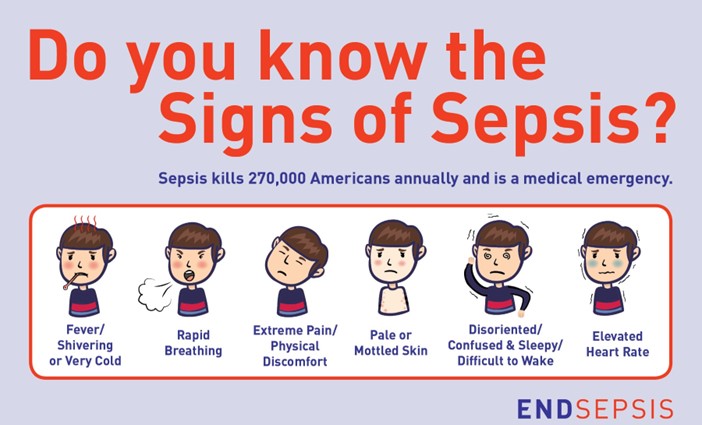Which of the following would the nurse expect to find in a newborn who is developing sepsis? Select one:
Hyperglycemia and increased appetite.
Increased urinary output and spitting up mucous.
Wakefulness and ruddy appearance.
Temperature instability and lethargy.
The Correct Answer is D
Choice A Reason: Hyperglycemia and increased appetite. This is an incorrect answer that describes symptoms of diabetes mellitus, not sepsis. Diabetes mellitus is a chronic metabolic disorder where the body cannot produce or use insulin effectively, which results in high blood glucose levels and impaired glucose tolerance. Diabetes mellitus can affect newborns if the mother has pre-existing or gestational diabetes, which can cause macrosomia, hypoglycemia, or congenital anomalies.
Choice B Reason: Increased urinary output and spitting up mucous. This is an incorrect answer that indicates normal or benign conditions, not sepsis. Increased urinary output is a normal finding in newborns, as they eliminate the excess fluid that was accumulated during pregnancy. Spitting up mucous is a common occurrence in newborns, as they clear their airways of amniotic fluid or secretions.
Choice C Reason: Wakefulness and ruddy appearance. This is an incorrect answer that suggests healthy or normal characteristics, not sepsis. Wakefulness is a sign of alertness and responsiveness in newborns, which reflects their neurological development and adaptation. Ruddy appearance is a reddish color of the skin that is normal in newborns, especially in term or post-term infants, which indicates adequate oxygenation and hemoglobin levels.
Choice D Reason: Temperature instability and lethargy. This is because temperature instability and lethargy are common signs of sepsis in newborns, which indicate systemic infection and inflammation. Sepsis is a life-threatening condition where the body's response to infection causes tissue damage, organ failure, or death. Sepsis can occur in newborns due to maternal, fetal, or neonatal factors, such as chorioamnionitis, premature rupture of membranes, prolonged labor, invasive procedures, or bacterial colonization.

Nursing Test Bank
Naxlex Comprehensive Predictor Exams
Related Questions
Correct Answer is B
Explanation
Choice A Reason: "You would have seen more symptoms if you had been looking more closely at your baby." This is an inappropriate response that blames the parents for missing the signs of sepsis and does not explain the Reason for the subtle symptoms.
Choice B Reason: "A newborn's immune system isn't mature, so symptoms are subtle and can be hard to recognize." This is an appropriate response that educates the parents about the immunological basis of sepsis in newborns and reassures them that they are not at fault for not noticing the symptoms.
Choice C Reason: "A high fever will always be present in sick newborns, including your baby." This is an incorrect response that contradicts the fact that newborns may not develop fever in response to infection due to their immature immune systems.
Choice D Reason: "A mother's immunity usually protects the infant from illness, but not in this case." This is an inaccurate response that implies that the mother failed to provide adequate immunity to her baby and does not address the question of why the baby did not seem very ill.
Correct Answer is C
Explanation
Choice A Reason: Macrosomic newborn. This is a correct answer that describes a possible complication of post-term pregnancy. A macrosomic newborn is a newborn that weighs more than 4000 grams or 8 pounds 13 ounces at birth. It can occur in post-term pregnancies due to prolonged exposure to maternal glucose and insulin. It can increase the risk of birth injuries, shoulder dystocia, cesarean delivery, and hypoglycemia.
Choice B Reason: Intrauterine growth restriction (IUGR). This is a correct answer that indicates a potential problem of post-term pregnancy. IUGR is a condition where the fetal growth is slower than expected for gestational age. It can occur in post-term pregnancies due to placental insufficiency, aging, or calcification, which can impair nutrient and oxygen delivery to the fetus. It can increase the risk of fetal distress, hypoxia, acidosis, and stillbirth.
Choice C Reason: Umbilical cord prolapse. This is an incorrect answer that does not reflect a risk of post-term pregnancy, but rather a risk of other factors such as prematurity, low birth weight, breech presentation, multiple gestation, polyhydramnios, or artificial rupture of membranes.
Choice D Reason: Meconium Aspiration Syndrome (MAS). This is a correct answer that denotes a possible complication of post-term pregnancy. MAS occurs when fetal stool (meconium) enters into the lungs before or during birth, causing airway obstruction, inflammation, and infection. MAS usually affects term or post-term infants who experience fetal distress or hypoxia in utero. It can cause respiratory distress syndrome (RDS), persistent pulmonary hypertension (PPHN), or chronic lung disease (CLD).
Whether you are a student looking to ace your exams or a practicing nurse seeking to enhance your expertise , our nursing education contents will empower you with the confidence and competence to make a difference in the lives of patients and become a respected leader in the healthcare field.
Visit Naxlex, invest in your future and unlock endless possibilities with our unparalleled nursing education contents today
Report Wrong Answer on the Current Question
Do you disagree with the answer? If yes, what is your expected answer? Explain.
Kindly be descriptive with the issue you are facing.
